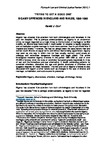Trying To Get A Good One’ Bigamy Offences in England and Wales, 1850-1950

Date
2012Author
Subject
Metadata
Show full item recordAbstract
Bigamy has attracted little attention from both criminologists and historians in the past few decades. This is perhaps understandable, as bigamy is an uncommon crime, no longer regarded as a major threat to the institution of marriage or familial stability, as divorce laws have made it much easier for couples to legally separate, and co-habitation outside marriage is much more common than in pre-World War II England and Wales. 2 However, this has not always been the case; before men and women could divorce on equal terms and without blame being apportioned, bigamy was seen as one way in which men (or less usually, women) could evade an unhappy and sometimes dangerous marriage and begin afresh. This article investigates recorded bigamy offences in the period 1850-1950 (a total of over 22,000 offences), when the rates of conviction fluctuated greatly (especially in times of war and the immediate post-war aftermaths). It details sentencing patterns for convicted offenders, discusses the age and gender structures of offenders and suggests reasons for these variations. The rise and fall of bigamy offences is also discussed with regard to other factors such as changes in the laws of divorce and marriage, co-habitation, and socio-economic pressures.
Citation
Cox, D. (2012) 'Trying To Get A Good One’ Bigamy Offences in England and Wales, 1850-1950', Plymouth Law and Criminal Justice Review, 4, pp. 1-32. Available at: https://pearl.plymouth.ac.uk/handle/10026.1/8970
Publisher
Journal
Volume
Recommended, similar items
The following license files are associated with this item:


